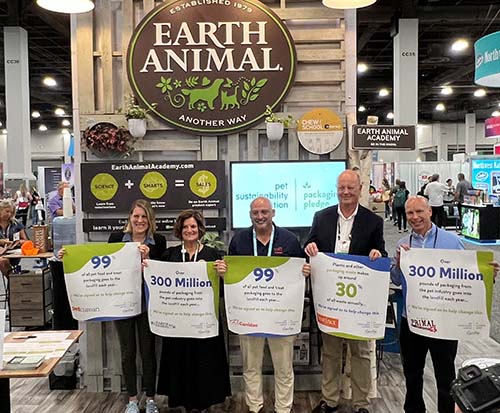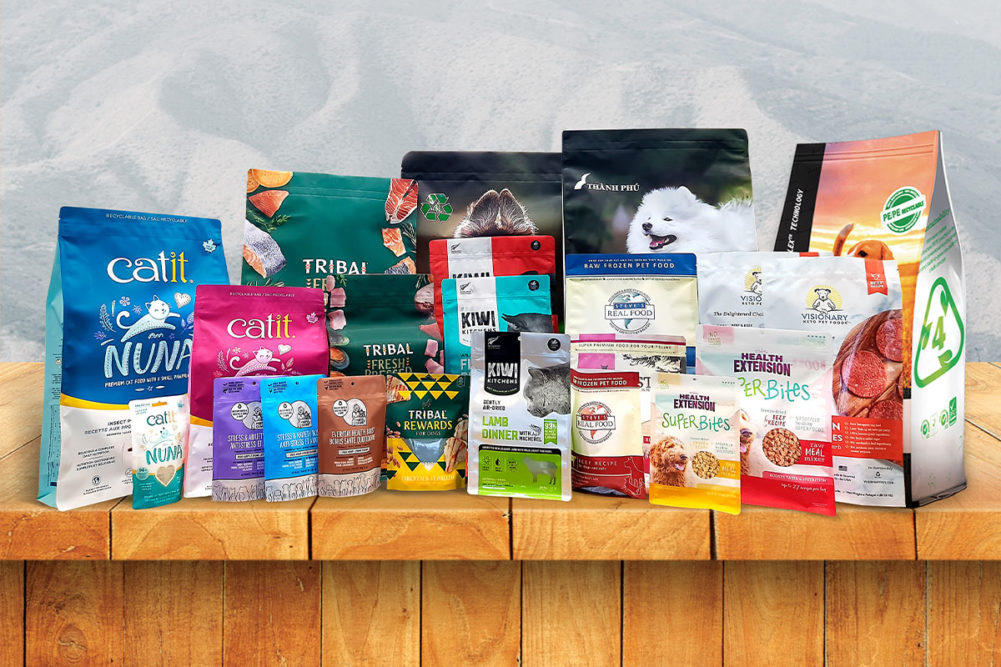This article was published in the December 2022 issue of Pet Food Processing. Read it and other articles from this issue in our December digital edition.
As the pet food industry moves toward a more sustainable future, recyclable packaging products are becoming more common. Recently, several leading pet food and packaging companies made a public commitment to sustainability by signing the Pet Sustainability Coalition’s (PSC) Packaging Pledge at SuperZoo 2022. The pledge is a voluntary commitment to move toward more sustainable, refillable, compostable and recyclable packaging.
The pledge asks pet industry companies to develop measurable goals and track progress toward the use of refillable, compostable and recyclable packaging by the end of 2025. In exchange for their commitment, PSC will provide informational tools, including:
- A marketplace of vetted, pre-qualified packaging suppliers
- Methods of measuring packaging life cycles
- Packaging design guides and labeling support from How2Recycle
- Legislative updates from North America and the European Union on sustainable packaging
- Marketing assets, including badges and social media promotion opportunities
“In exchange for their commitment, PSC is providing signatories with tools such as packaging benchmarking tools, North American and EU legislative briefs, a marketplace of pre-vetted packaging suppliers, communication assets, project support, and more,” said Caitlyn Dudas, executive director of the PSC, Boulder, Colo. “The PSC Packaging Pledge represents a powerful opportunity for us to collaborate in significantly reducing the industry’s impact on the environment. We are proud to spearhead this initiative and help drive more sustainable and successful business.”
The positive impact of change
The use of recyclable packaging offers many benefits, including reducing the amount of waste that ends up in landfills. In addition, the production of recyclable packaging often requires less energy and water, and creates fewer greenhouse gas emissions than non-recyclable packaging.
“The greatest benefit of using recyclable packaging is reducing the impact we as an industry have on the environment,” said Dave McCoy, director of strategic sourcing, Instinct Pet Food, St. Louis, Mo. “By utilizing recyclable packaging, we’re moving material away from landfills and into recyclable streams that can use those bags to make other products.”
“There are additional significant benefits that consumers may not realize, that are reaped before the kibble even hits the bag,” added Christine Mallier, sustainability and community relations manager, Petcurean, Chilliwack, British Columbia. “From the sourcing of the material and manufacturing to the transporting of the bags, there are reductions in greenhouse gas emissions, water use, mineral resource use, human impact and freshwater ecotoxicity.”
 During SuperZoo 2022, five pet food manufacturers — Canidae, Earth Animal, Instinct, Petcurean and Primal Pet Foods — publicly signed the PSC’s Packaging Pledge, making a commitment toward using more refillable, compostable and recyclable packaging through 2025. (Source: Sosland Publishing Co.)
During SuperZoo 2022, five pet food manufacturers — Canidae, Earth Animal, Instinct, Petcurean and Primal Pet Foods — publicly signed the PSC’s Packaging Pledge, making a commitment toward using more refillable, compostable and recyclable packaging through 2025. (Source: Sosland Publishing Co.)
More and more consumers are becoming concerned about the environment and are choosing brands that are making an effort to be sustainable. By using recyclable packaging, pet food companies can show their commitment to sustainability and attract more environmentally conscious consumers. Committing to sustainability could also help companies attract and retain talent.
“We are seeing more and more consumers increasingly prioritize the purchasing decisions around the environment and choosing to support brands that share their values,” Mallier said. “And, as more Gen Z’s start to enter the workforce in the coming years, we know that they will also seek out employers that share similar values. As such, companies with strong sustainability practices — like those that use recyclable packaging — will likely see an advantage when it comes to attracting and retaining employees.”
Sustainable packaging solutions
Pet food and treat manufacturers have a variety of recyclable packaging materials to choose from. The choice of material depends on a number of factors, including the type of product being packaged, transportation and storage considerations, safety standards and cost.
“As we transition to more sustainable packaging across our Primal Pet Foods line, we don’t take a one-size-fits-all approach,” said Megan Pearson, director of major and strategic accounts and sustainability committee lead, Primal Pet Foods, Fairfield, Calif. “We work with our packaging suppliers to evaluate the different recyclable materials available and determine which is best suited for each product based on several factors. In addition to protecting our food and treats while they are being transported and handled, our packaging materials need to be able to maintain our high standards for quality and safety.”
“We are seeing more and more consumers increasingly prioritize the purchasing decisions around the environment and choosing to support brands that share their values,” said Christine Mallier of Petcurean.
Single-layer polyethylene is one of the most widely used types of recyclable packaging for pet food and treats. It offers a number of benefits, including being lightweight, strong and moisture resistant. The single-layer construction also makes it easy to recycle, unlike multi-layer materials.
“Traditional flexible packaging consists of a multilayered structure with materials like polyester and polyethylene… Recycling centers are unable to separate the different films, thus rendering them unrecyclable,” McCoy explained. “The packaging and pet food industry is moving toward more sustainable, single (mono) structure bags made of polyethylene that are recyclable through store drop-off sites.”
“The companion pet industry creates more than 300 million lbs of flexible plastic packaging in North America each year,” Dudas added. “Unfortunately, 99% of multi-laminate packaging used for most pet food and treats does not have a sustainable end-of-life solution and ends up in landfills. Our Packaging Pledge supports brands and suppliers as they commit to making measurable progress towards refillable, compostable and/or recyclable packaging solutions by the end of 2025.”
Thanh Phu Plastic Packaging Co., Ho Chi Minh, Vietnam, is one company that has made a commitment to sustainable packaging solutions. As a founding donor of the Packaging Pledge and recognized pioneer in developing sustainable flexible packaging, Thanh Phu has been working to create more eco-friendly packaging for the pet food industry.
“Pet food packaging, especially for kibble, requires high-impact strength, large format pouches up to 20 kgs,” said Alex Dam, executive vice president, Thanh Phu Plastic Packaging Co. “In addition, some pet food and treats contain high protein and fat content, requiring a hermetic seal with a good oxygen and moisture barrier. Our Veloflex™ Low Density Polyethylene (LDPE) solution provides outstanding heat sealability and impact strength for a large temperature range from sub-zero to normal warehouse temperatures. Additionally, PE resin is abundantly available with good economies of scale to meet the transition from non-recyclable to fully recyclable mono-polyethylene packaging.”
Overcoming challenges
The many benefits of using recyclable packaging materials also come with some challenges. These include the properties of the materials themselves, the infrastructure needed to recycle them, and consumer education to ensure that packaging is properly recycled.
“Recyclable bags have historically not been as strong and durable as non-recyclable bags,” said Dave McCoy of Instinct Pet Food.
One challenge is finding recyclable materials that meet the performance requirements of pet food packaging. Although there has been a lot of progress in this area, it can take time for new materials to be fully tested and approved for use. Additionally, the availability of certain materials can be limited, which can impact cost.
“Recyclable bags have historically not been as strong and durable as non-recyclable bags,” McCoy said. “Technology and films are improving in such a way where that gap in performance is shrinking, but oftentimes, there is a learning curve to implement... In addition, some recyclable material is simply not as readily available as its non-recyclable counterparts. That will change over time as more brands and suppliers increase their sustainability efforts and move to recyclable films. In the near term, proper forecasting and planning are needed to ensure access to material.”
In terms of infrastructure, not all areas have the necessary facilities to process recyclable materials. This can make it difficult to ensure that packaging is properly recycled and does not end up in landfills. However, drop-off recycling centers are becoming more common, which makes it easier for consumers to recycle their packaging.
Finally, many consumers are not aware of the importance of recycling or how to properly recycle their packaging. This can lead to packaging being thrown in the trash instead of being recycled. Pet food brands will need to continue to educate consumers on the importance of recycling and how to do it successfully.
“One of the key challenges of using recyclable packaging in the pet food industry is that this type of packaging needs to be properly recycled at recycle depots or store drop-off locations to reap the full benefits of it,” Mallier said. “This is a challenge which requires a change in consumer behavior. With that said, it’s up to brands to help overcome this challenge through education — to retailers and consumers directly — and through their various marketing channels, like social media.”
The evolving role
As the pet food industry continues to evolve, the role of recyclable packaging will also change. More and more brands are likely to switch to recyclable packaging as they look for ways to reduce their environmental impact, and new technologies and materials will continue to emerge.
“The near-term trend is moving toward recyclable bags, but there are many exciting possibilities for the future, including packaging that is compostable, biodegradable or refillable,’’ McCoy said. “As more brands incorporate these emerging, sustainable options into their portfolios, the more widely available they will become for the industry as a whole.”
“It’s about progress, not perfection,” Pearson added. “We are committed to transitioning to more sustainable packaging across our Primal Pet Foods line over the next few years. As our industry makes this commitment, we expect to see an evolution in the recyclable materials and formats that are being used.”
Although there is still a long way to go, initiatives like the PSC’s Packaging Pledge are helping to move the industry in the right direction. As more brands commit to using recyclable packaging, the availability of these materials will increase and the challenge of recycling will become easier to overcome. Through a combination of efforts, the pet food industry will be able to make significant progress in reducing its environmental impact.
“Flexible plastic packaging can help prevent food waste throughout the supply chain from farm to table, with the lowest carbon footprint, compared with existing alternatives such as glass, metals and fiber,” Dam said. “In the new era of environmental conscience, the drawback of lightweight non-recyclable packaging becomes more significant and needs to be addressed.”
Read more about packaging solutions and trends for pet food and treats.




